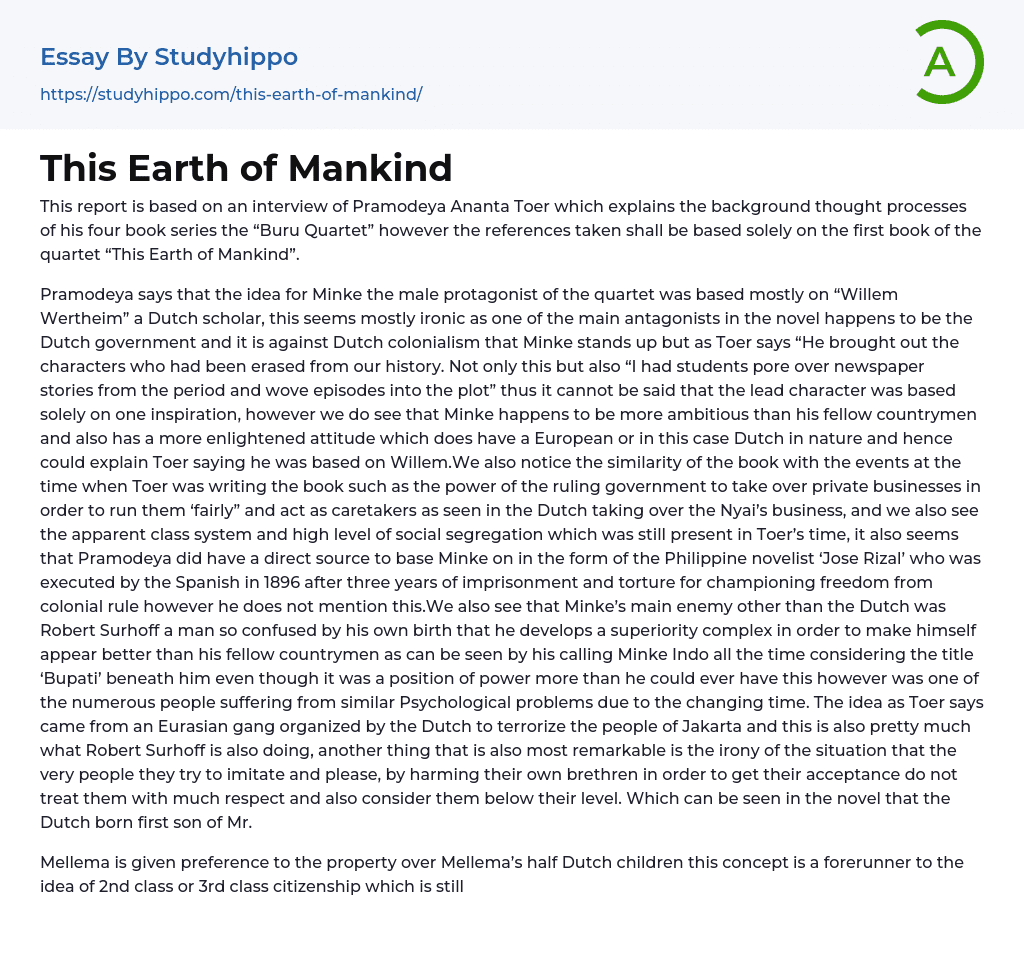The content of this report focuses on an interview with Pramodeya Ananta Toer where he discusses the inspiration and thinking behind his four-part book series known as the "Buru Quartet", with specific reference to only the first book of the quartet titled "This Earth of Mankind".
According to Pramodeya, Minke, the male protagonist of the quartet, was largely inspired by Willem Wertheim, a Dutch scholar. This is particularly ironic, considering that one of the major villains in the novel happens to be the Dutch government and Minke stands up against Dutch colonialism. However, as Toer points out, Pramodeya brings to light characters who have been erased from our history.The lead character in Toer's book was not based solely on one inspiration. To create Minke, Toer had students study newspaper stories from the period and incorporated the events into the p
...lot. While Minke shares similarities with Willem and his European beliefs, he also stands out as more ambitious than his fellow Indonesians. The book's setting, which includes the ruling government's power to take over private businesses and issues of class and social segregation, reflects the events of Toer's time. Although the author did not explicitly mention it, Minke may have been directly based on Philippine novelist Jose Rizal, who was executed for campaigning for colonial freedom. Minke's main adversary, Robert Surhoff, suffered from a superiority complex due to personal psychological issues stemming from the changing times.Toer attributes the idea to an Eurasian gang formed by the Dutch to terrorize the inhabitants of Jakarta. Similar activities are being carried out by Robert Surhoff. The situation is ironic as those whom they strive to emulate and appease
by harming their own kind to gain acceptance, do not hold them in high regard and consider them inferior. This is evident in the story of the Dutch native, Mr. Toer's eldest son.
Mellema's preference for property over his half-Dutch children foreshadows the idea of second or third-class citizenship and is a remnant of colonialist racism. Pramodeya drew inspiration from John Steinbeck's "Of Mice and Men," as well as the works of Gorky and Tolstoy, evident in his incorporation of the theme "try to understand each other" into his quartet. He shows the consequences when individuals and communities fail to comprehend opposing perspectives and assert superiority. Steinbeck's concepts of dreams, loneliness, man's cruelty towards prosperity, powerlessness, and uncertain fate are also evident in Minke's journey through the first novel. His fame draws enmity from Rubert Surhoff, Mellema, and even his own brother. He dreams of bettering not just his own life, but that of his peers. However, he is powerless in the face of unexpected events and "fate."
From Gorky's writing, Pramodeya gained inspiration for portraying Indonesia's social fabric and the unique traits and psychology of its people within his novel.
- Christopher Columbus essays
- Pilgrims essays
- Simon Bolivar essays
- Exploration essays
- Book Summary essays
- Metaphor essays
- Reader essays
- Rhyme essays
- Literary devices essays
- Villain essays
- Books essays
- Genre essays
- Literary Criticism essays
- Writer essays
- Protagonist essays
- Simile essays
- Poem essays
- Book Report essays
- Book Review essays
- Greek Mythology essays
- Plot essays
- Tragic Hero essays
- Coming of Age essays
- Play essays
- Rhetoric essays
- Rhetorical Question essays
- Translation essays
- Understanding essays
- Reason essays
- Character essays
- Letter essays
- American Literature essays
- Literature Review essays
- Utopia essays
- Poetry Analysis essays
- Dante's Inferno essays
- Between The World and Me essays
- Incidents in The Life of a Slave Girl essays
- Flowers for Algernon essays
- Myth essays
- Everyday Use essays
- Boo Radley essays
- Genesis essays
- Richard iii essays
- Alice in Wonderland essays
- On the road essays
- Ozymandias essays
- The Nightingale essays
- Holden Caulfield essays
- Animal Farm essays




